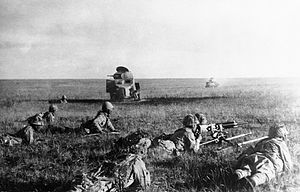Battles of Khalkhin Gol
| Battles of Khalkhin Gol/Nomonhan | |||||||||
|---|---|---|---|---|---|---|---|---|---|
| Part of the Soviet–Japanese border conflicts | |||||||||
 Japanese infantrymen near wrecked USSR armored vehicles, July 1939 | |||||||||
| |||||||||
| Belligerents | |||||||||
|
| |||||||||
| Commanders and leaders | |||||||||
| |||||||||
| Strength | |||||||||
|
61,860–73,961[a]
4,000 trucks[8] 1,921 horses and camels (Mongol only)[9] |
c. 20,000–30,000[10]
1,000 trucks[11] 2,708 horses[12] | ||||||||
| Casualties and losses | |||||||||
|
Manpower: Equipment: 208 aircraft[15] 253 tanks destroyed[16][c] 133 armored cars destroyed 96 mortars and artillery 49 tractors and prime movers 652 trucks and other motor vehicles[13][14] significant animal casualties[17] |
Manpower: | ||||||||
Location within Mongolia | |||||||||
The Battle of Khalkhin Gol was a battle that was fought between the Soviet Union and Mongolia, against Japan. This battle was fought in Manchuria, located in the northeast of China. The battles happened from 11 May 1939 to 16 September 1939. The Soviets and Mongolians won the battles.
The battle was named after a river located on the battlefield called Khalkhin Gol.
References
- ↑ Kotelnikov 2010, p. 109.
- ↑ 2.0 2.1 2.2 2.3 Khalkhin Gol Battle: the Revision of Statistics. Retrieved 21 June 2015.
- ↑ "Classification of secrecy has been removed: losses suffered by USSR Armed Forces in wars, combat operations, and military conflicts" (PDF). Department of the Army. 10 August 2006. Retrieved 6 May 2022.
- ↑ "The Chief Culprit", by Viktor Suvorov,
- ↑ 5.0 5.1 5.2 Zaloga, p. 13.
- ↑ 6.0 6.1 V. Kondratiev, "Khalkhin Gol: War in the Air" retrieved 3 January 2016
- ↑ "The Chief Culprit", by Viktor Suvorov, p.[page needed].
- ↑ Coox 1985, p. 580.
- ↑ "The Khalkhin Gol Battle, 1939" Retrieved 3 January 2016
- ↑ Bellamy and Lahnstein (1990) The New Soviet Defensive Policy: Khalkhin Gol 1939 as Case Study Archived 11 December 2016 at the Wayback Machine p. 24
- ↑ Coox 1985, p. 563.
- ↑ 12.0 12.1 Coox 1985, p. 1168.
- ↑ 13.0 13.1 M. Kolomiets "Boi u reki Khalkhin-Gol" Frontovaya Illyustratsia (2002)
- ↑ 14.0 14.1 Soviet Losses in the Khalkhin Gol Battle. Retrieved 21 July 2015.
- ↑ 15.0 15.1 Кондратьев В. Халхин-Гол: Война в воздухе. — М.: Библиотека журнала "Техники – Молодежи". Серия "Авиация", 2002. — 64 с. Тираж 1000 экз.ISBN 5-88573-009-1.
- ↑ "Soviet Losses in the Khalkhin-Gol Battle". armchairgeneral.com. Retrieved 6 May 2022.
- ↑ Coox 1985, p. 576.
- ↑ Nomonhan: Japanese-Soviet Tactical Combat, 1939. Leavenworth Papers №2. by Edward J. Drea" Combat Studies Institute, fort Leavenworth, Kansas, 1981
- ↑ Glantz, David M.; and House, Jonathan. When Titans Clashed: How the Red Army Stopped Hitler. Lawrence, KS: UP of Kansas, 1995. ISBN 0-7006-0899-0 p. 14.
- ↑ Coox 1985, p. 987.
- ↑ Coox, "Nomonhan: Japan against Russia" There are multiple accounts of Japanese trucks being knocked out by Soviet artillery and aviation, as well as losses due to mechanical failures or environmental hazards.
Sources
- Coox, Alvin D. (1985). Nomonhan: Japan Against Russia, 1939. Two volumes. Stanford University Press. ISBN 0-8047-1160-7.
- Kotelnikov, Vladimir R. (2010). Air War Over Khalkhin Gol, The Nomonhan Incident. SAM publications. ISBN 978-1-906959-23-4.
- Zaloga, Steven J. (2007). Japanese Tanks 1939–45. Osprey. ISBN 978-1-84603-091-8.
Notes
- ↑ Includes at least 57,000 Soviet[1] and 4,860 MPR personnel.[2] Combined Soviet-MPR strength was possibly as high as 74,000.[3]
- ↑ 9,703 dead and missing:[13] 15,952 wounded, 2,225 hospitalized due to disease
- ↑ These losses break down as: 30 BT-7s, 27 BT-7RTs,2 BT-7As, 127 BT-5s, 30 BT-5RTs, 8 T-26s, 10 KhT-26S, 2 KhT-130S, and 17 T-37s. This does not include tanks that only sustained light to moderate damage, or ones lost due to mechanical failure.
- ↑ Japanese claim: 8,440 killed, 8,766 wounded
Soviet claim:60,000 killed and wounded, 3,000 captured[19]
Equipment:
160 aircraft[15]
29 tanks destroyed or crippled[5]
Many tankettes destroyed
72 artillery pieces (field guns only)[20]
2,330 horses killed, injured, or sick[12]
significant motor vehicle losses[21]

